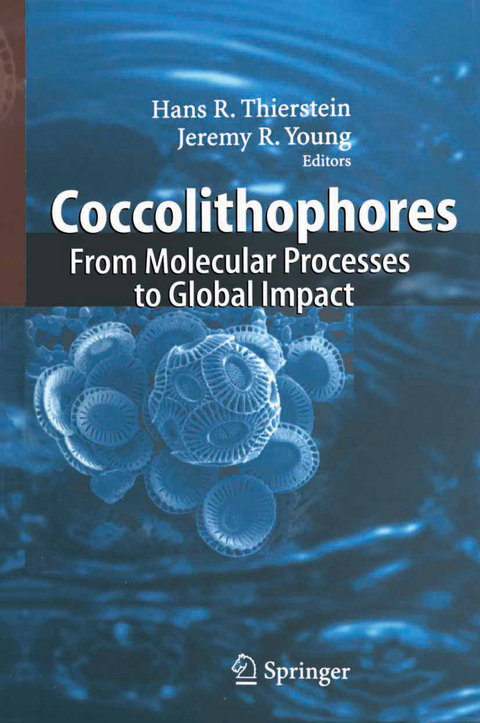
Coccolithophores
Springer Berlin (Verlag)
978-3-642-06016-8 (ISBN)
In the past few years rapid progress has been made regarding our understanding of one of the dominant phytoplankton groups of the world's oceans: the coccolithophores. Among other initiatives, the EU-funded TMR network CODENET (Coccolithophores Evolutionary Biodiversity and Ecology Network) has provided new results and insights. These and many other findings are reviewed and synthesized in a number of individual chapters which focus on coccolithophore biology (molecular to cellular), ecology (experimental and in the ocean), evolutionary phylogeny and its impact on current and past global changes. Coccolithophores are emerging as a prime model for interdisciplinary global change research due to their great abundance, wide distribution and exemplary geological record. The results presented in this book address the fundamental question of the interaction between the biota and the environment at various temporal and spatial scales.
1: Cell Biology and Biochemistry.- What is new in coccolithophore biology?.- Calcification in coccolithophores: A cellular perspective.- Pigment diversity of coccolithophores in relation to taxonomy, phylogeny and ecological preferences.- 2: Physiology and bloom studies.- Emiliania huxleyi: bloom observations and the conditions that induce them.- Coccolithophore calcification and the biological pump: response to environmental changes.- Dimethyl sulfide production: what is the contribution of the coccolithophores?.- Re-evaluation of the physiological ecology of coccolithophores.- Structure and morphogenesis of the coccoliths of the CODENET species.- The laboratory culture of coccolithophores.- 3: Molecular phytogeny and evolutionary biodiversity.- A review of the phylogeny of the Haptophyta.- Super-Species in the calcareous plankton.- Coccolithophorid biodiversity: evidence from the cosmopolitan species Calcidiscus leptoporus.- Species level variation in coccolithophores.- Coccolith contribution to South Atlantic carbonate sedimentation.- Biogeography of selected Holocene coccoliths in the Atlantic Ocean.- 4: Evolutionary development, fluxes and paleoproxies.- Why is the land green and the ocean red?.- Plankton community behavior on ecological and evolutionary timescales: when models confront evidence.- Calcareous nannoplankton evolution and diversity through time.- Carbonate fluxes and calcareous nannoplankton.- Coccolithophorid-based geochemical paleoproxies.- 5: Index.
lt;p>Aus den Rezensionen:
"Als eine Hauptkomponente des rezenten ozeanischen Planktons kommt den Coccolithophoren eine zunehmend große wissenschaftliche Bedeutung zu. ... Diesen umfangreichen interdisziplinären Themenkomplexen wird das Buch ... voll gerecht. ... Die Vorteile dieses 'state of the art-Kompendiums' würdigte der Rez. bereits eingangs. Das mit seinen Beiträgen stark interdisziplinär angelegte Werk wirkt deutlich stimulierend auf biologisch wie auch mikropaläontologisch und (paläo)ozeanologisch orientierte Forschende. ... für jeden interdisziplinär arbeitenden (Paläo )-Planktologen ist es ein Muss."
(in: Zentralblatt für Geologie und Paläontologie Teil II, 2006, Issue 5-6, S. 898 ff.)
| Erscheint lt. Verlag | 30.11.2010 |
|---|---|
| Zusatzinfo | XIII, 565 p. |
| Verlagsort | Berlin |
| Sprache | englisch |
| Maße | 155 x 235 mm |
| Gewicht | 862 g |
| Themenwelt | Naturwissenschaften ► Geowissenschaften ► Mineralogie / Paläontologie |
| Schlagworte | biochemistry • biodiversity • biological oceanography • Biology • Cell • Cell Biology • Chemistry • climate change • Development • Ecology • Environment • Evolution • global change • Marine Biology • ocean • Oceanography • Palaeontology • Paleoceanography • Physiology • Phytoplankton • Plankton |
| ISBN-10 | 3-642-06016-1 / 3642060161 |
| ISBN-13 | 978-3-642-06016-8 / 9783642060168 |
| Zustand | Neuware |
| Haben Sie eine Frage zum Produkt? |
aus dem Bereich


